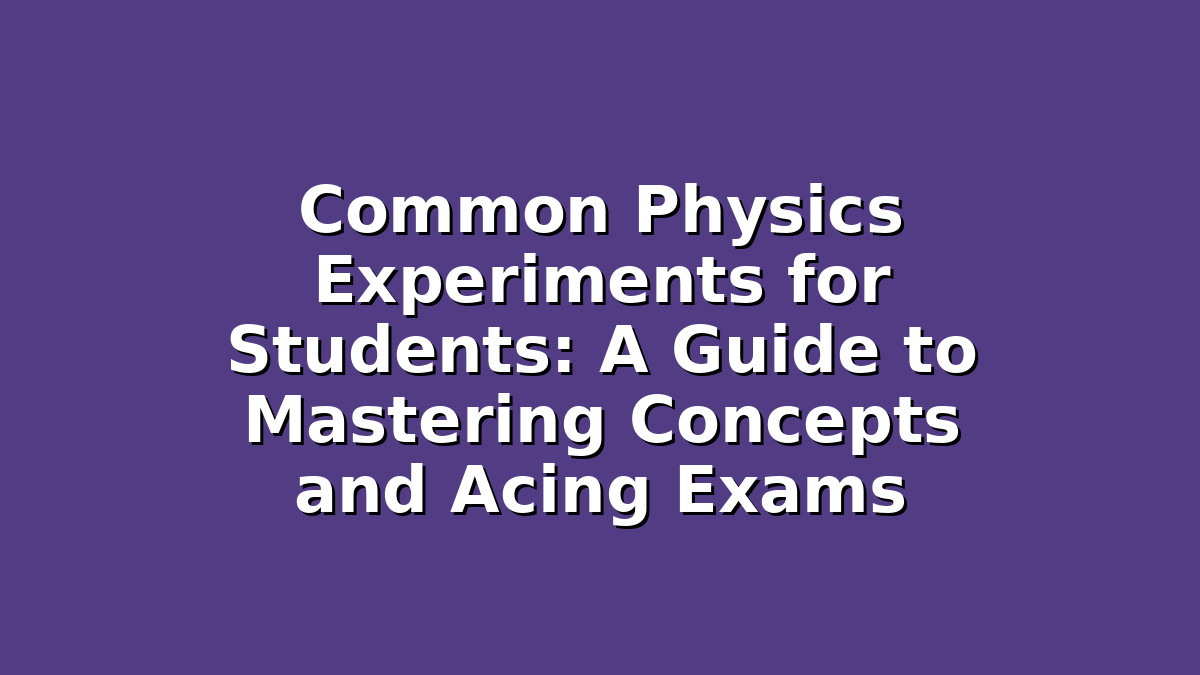Physics can sometimes feel like a challenging subject, filled with complex formulas, abstract theories, and intricate concepts. However, one of the best ways to truly understand physics is through hands-on experiments. Performing physics experiments not only makes learning more engaging but also helps you grasp difficult ideas and prepares you effectively for exams. Whether you’re a high school student or a college freshman, familiarizing yourself with common physics experiments can boost your confidence and deepen your understanding.
In this article, we’ll explore some essential physics experiments that every student should know about. Along the way, we’ll offer practical study tips and advice to help you get the most out of these experiments and excel in your physics exams.
1. Mechanics Experiments: Understanding Motion and Forces
Mechanics is a fundamental branch of physics that deals with motion, forces, and energy. Many common physics experiments focus on these topics, making them ideal for building a strong conceptual foundation.
Popular Mechanics Experiments:
– The Pendulum Experiment: This classic experiment helps students explore periodic motion, time period, and the factors affecting oscillations. By measuring the time period of a simple pendulum for different lengths, you can verify the mathematical relationship ( T = 2pi sqrt{frac{L}{g}} ), where (T) is the time period, (L) is the length, and (g) is the acceleration due to gravity.
– Newton’s Second Law Experiment: Using a trolley on a track with varying masses and applied forces, students can verify the relation ( F = ma ). This experiment demonstrates how force, mass, and acceleration are interconnected.
– Inclined Plane Experiment: Studying an object rolling or sliding down an inclined plane helps you grasp concepts like acceleration due to gravity, friction, and energy conservation.
Study Tips:
– Draw diagrams: While preparing for exams, sketch clear diagrams of the experimental setups and label every part. Visual aids help reinforce memory and make it easier to recall details during tests.
– Understand formulas: Don’t just memorize formulas; understand how they relate to the experiment you performed. For example, knowing why the pendulum’s period depends on the square root of its length gives insight into the physics behind it.
– Practice calculations: Use your experimental data to perform calculations repeatedly. This builds confidence in handling numerical problems during exams.
2. Electricity and Magnetism Experiments: Exploring Currents, Circuits, and Fields
Electricity and magnetism are critical areas in physics and are heavily tested in exams. Hands-on experiments in this field clarify the behavior of electric currents, magnetic fields, and their interactions.
Common Electricity and Magnetism Experiments:
– Ohm’s Law Verification: Using a circuit with a resistor, ammeter, and voltmeter, students measure current and voltage to verify ( V = IR ). This experiment is simple yet crucial for understanding electrical circuits.
– Series and Parallel Circuits: Building different circuit arrangements helps you observe how current and voltage divide, giving practical insight into circuit theory.
– Magnetic Field Mapping: Using a bar magnet and iron filings, you can visualize magnetic field lines, which helps understand the nature and direction of magnetic forces.
Study Tips:
– Make summary tables: Create tables comparing current, voltage, and resistance values in different experiments. Summaries help you quickly review the effects of changing variables.
– Relate theory to experiment: Connect the behavior you observe in the lab to the underlying principles, such as how voltage drops in series circuits or how magnetic fields exert forces on moving charges.
– Recreate circuits at home: If possible, build simple circuits using batteries, bulbs, and wires to reinforce your learning outside class. Repetition strengthens comprehension.
3. Optics Experiments: Studying Light and Its Properties
Optics is another fascinating branch of physics where experiments reveal the behavior of light — its reflection, refraction, and dispersion. These experiments are visually engaging and offer excellent opportunities to apply formulas and laws.
Key Optics Experiments:
– Reflection and Refraction of Light: Using a ray box and a glass slab, you can measure angles of incidence, reflection, and refraction. This verifies laws such as the angle of incidence equals the angle of reflection and Snell’s Law of refraction.
– Lens Focal Length Determination: By focusing light through convex and concave lenses, students determine focal lengths using lens formula ( frac{1}{f} = frac{1}{v} – frac{1}{u} ), where (f) is focal length, (v) is image distance, and (u) is object distance.
– Dispersion with a Prism: Experiments with prisms demonstrate how white light disperses into the spectrum of colors, explaining the phenomenon of rainbows and color separation.
Study Tips:
– Practice angle measurements: Accurate measurement of angles is crucial in optics experiments. Use protractors carefully and practice reading scales to improve precision.
– Memorize key laws: Laws like Snell’s Law and the mirror/lens formula are essential. Write them down repeatedly and try applying them to different experimental scenarios.
– Use real-world examples: Linking optics concepts to everyday experiences — like how eyeglasses work or why the sky is blue — can help solidify your understanding and make revision enjoyable.
Conclusion
Physics is best learned by doing. Performing common physics experiments helps cement theoretical knowledge, making it easier to recall during exams. Mechanics, electricity and magnetism, and optics are core topics where practical experimentation offers invaluable insights. By actively engaging with these experiments, drawing detailed diagrams, practicing calculations, and connecting theory with practice, you set yourself up for success.
Remember, the goal is not just to pass exams but to truly understand the fascinating principles that govern the physical world. Approach your experiments with curiosity and patience, and use the study tips provided to deepen your understanding and boost your confidence.
Stay consistent, practice regularly, and don’t hesitate to seek help from teachers or peers when you encounter difficulties. With effort and the right approach, mastering physics experiments will become an enjoyable and rewarding part of your learning journey.
Good luck, and happy experimenting!

Responses